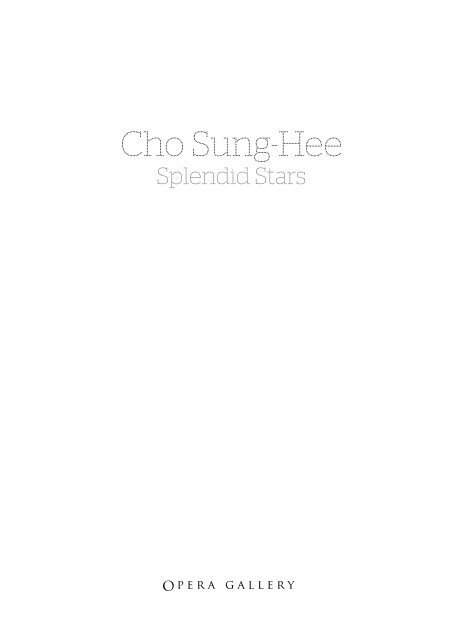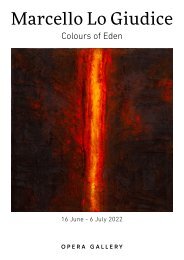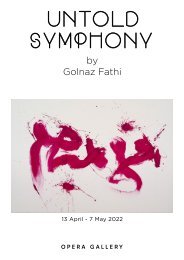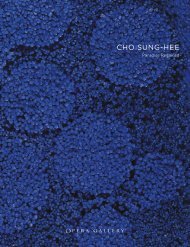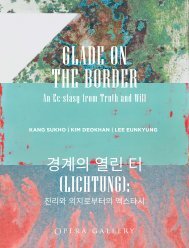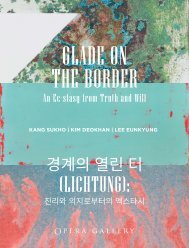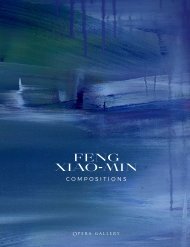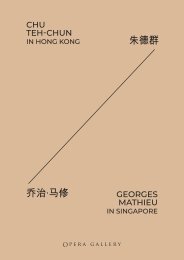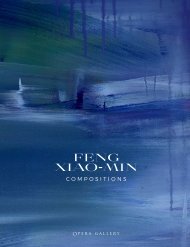Cho Sung-Hee: Splendid Stars
Cho Sung-Hee: Splendid Stars Solo exhibition in London, March 2018
Cho Sung-Hee: Splendid Stars
Solo exhibition in London, March 2018
You also want an ePaper? Increase the reach of your titles
YUMPU automatically turns print PDFs into web optimized ePapers that Google loves.
<strong>Cho</strong> <strong>Sung</strong>-<strong>Hee</strong><br />
<strong>Splendid</strong> <strong>Stars</strong>
Preface<br />
Opera Gallery is delighted to present <strong>Cho</strong> <strong>Sung</strong>-<strong>Hee</strong>’s first exhibition with us. Korean artist<br />
<strong>Cho</strong> <strong>Sung</strong>-<strong>Hee</strong> looks for balance on her canvases through her mastery of materials and colours.<br />
She creates through her works a fascinating world that we are pleased to bring forward.<br />
<strong>Cho</strong> <strong>Sung</strong>-<strong>Hee</strong>’s works incarnate a string of opposites under a seemingly calm surface. She<br />
combines Korean Hanji paper, a traditional material, with oil paint, rather than its archetypal<br />
association with Asian inks. Through other creative steps, she comes to her own method and<br />
uses this synthesis to create abstract but meticulous works, mesmerising to the eye and the<br />
mind.<br />
<strong>Cho</strong>’s works, divided into monochromatic (named after numbers and letters) and polychromatic<br />
ones, require a lengthy production. Each Hanji piece is shaped and painted by hand, it is then<br />
integrated into the larger composition on canvas. The artist creates a very limited number of<br />
works each year. Making a surface that seems to be void, she works intricately with different<br />
colours and surfaces inspired by the nature and the world around us.<br />
Many themes interact in <strong>Cho</strong>’s works, from the smallest grain to the infinite. We can observe<br />
some of these from her titles – she works with concrete elements of the nature, such as flower<br />
blossoms, to something much more metaphysical, the cosmic and the universe. The show’s title<br />
is a tribute to the artist whose first name <strong>Sung</strong>-<strong>Hee</strong> means ‘stars’ (<strong>Sung</strong>) and ‘splendour’ (<strong>Hee</strong>).<br />
Those are some of the feelings her works evoke and we would like to bring to you.<br />
We welcome <strong>Cho</strong> <strong>Sung</strong>-<strong>Hee</strong> to Opera Gallery and are proud to count her as one of our Korean<br />
contemporary talents, whom we have exhibited in curated exhibitions throughout the years. We<br />
hope you find as much beauty and pleasure in these works as we do.<br />
Gilles Dyan, Founder and Chairman, Opera Gallery Group<br />
Sebastien Plantin, Director, Opera Gallery London<br />
Work 1 (detail),<br />
2017<br />
3
Viewing<br />
the Universe<br />
and Life<br />
Since the mid s, the Korean contemporary art community has increasingly utilised Asian<br />
mulberry paper – Hanji in Korean – as a significant medium of expression. efore this time, Hanji<br />
was mainly used by oriental painters or merely used as a currency wrap. Many contemporary<br />
artists saw abundant potential to manifest Hanji as an integral part of their artistic vision<br />
and over time became a natural medium of common interest. n the s, Dansaekhwa, the<br />
Monochrome Art Movement, artists such as Kwon oung-Woo, Chung Chang-Sup, ark Seo-o<br />
further investigated the possibilities of working with Hanji. Artists such as <strong>Cho</strong>i Chang-Hong,<br />
Ham Sup, Han oung-Sup, Han Gi-u, ark Chul and oo ae-Gu started to focus on mulberry<br />
paper as a main medium for their work and became founding members of the Hanji Artist<br />
Association of Korea.<br />
The plasticity of the medium, Hanji, is well suited to express the unique essence of Korean<br />
culture. When submerged in water, mulberry paper can be sculpted into any form. As an artist<br />
who also shows an exceptional sensibility towards sculptural form, <strong>Cho</strong> <strong>Sung</strong>-<strong>Hee</strong> and mulberry<br />
paper form an obvious synthesis and it is as if the artist and the medium were destined to<br />
interact. Starting to work with mulberry paper in the turn of st century was a natural course<br />
of action for an artist who started her career from representational painting into abstraction.<br />
<strong>Cho</strong> <strong>Sung</strong>-<strong>Hee</strong>’s work can be viewed as a condensation of her existence and epitome of life itself.<br />
Every facet of her work reflects the artist’s limitless imagination. For example, representations<br />
of the infinite abundance of the stars above endless lotus leaves arranged across the surface<br />
of a tranquil pond or an overgrown field adorned with clovers. We can start to grasp the inner<br />
thought of the artist as multiple imagery floods into us as one. nique methods behind the<br />
making of an artwork as a vehicle of communication between the maker and the audience.<br />
Through this perspective, we can finally have an in-depth conversation with <strong>Cho</strong> <strong>Sung</strong>-<strong>Hee</strong>.<br />
And, through this perspective, we can sense her indomitable will and flaming passion that can<br />
even melt steel. We ask the question when looking at the remains of her life experience in<br />
retrospect what has fired her passion to this extent<br />
sing the imagery of leaves, galaxies and mushrooms as a metaphor for the natural obect, <strong>Cho</strong><br />
<strong>Sung</strong>-<strong>Hee</strong>’s work constantly reminds us of the vastness of nature. When viewing her work, we<br />
imagine nature that existed through our experience. That imagination may be of an endless<br />
meadow filled with clover, lotus laying on the surface of a still pond, a field filled with roses or<br />
Reflection (detail),<br />
2014<br />
5
<strong>Cho</strong> <strong>Sung</strong>-<strong>Hee</strong>’s<br />
work constantly<br />
reminds us<br />
of the vastness<br />
of nature.<br />
even an infinite sky filled with innumerable gleaming stars. ut<br />
the most significant response comes when we start to understand<br />
her life and realise how much it resembles ours.<br />
As we all know, this mysterious power of art comes from the<br />
consistent ‘desire of art’ present and manifest inside the artist.<br />
We can therefore only start to understand how <strong>Cho</strong> <strong>Sung</strong>-<strong>Hee</strong> has arrived at monochromatic<br />
and polychromatic ‘obet dart’ through mulberry paper by looking back into <strong>Cho</strong> <strong>Sung</strong>-<strong>Hee</strong>’s<br />
pilgrimage as an artist.<br />
Life in the Galaxy ( x cm, ) and Floating Sun ( x cm, ) are critical works<br />
which show <strong>Cho</strong> <strong>Sung</strong>-<strong>Hee</strong>’s insight on universe and life. The representation of the limitless<br />
universe we see here is a reflection of her life in a microcosm and equates to the life of an artist.<br />
Similar to her older works, Contemplating Death (), <strong>Cho</strong>’s recent series, through composing<br />
deep blue, black and red as her main palette, delivers a spatial sensation while it fully reveals<br />
‘the world of deep silence and that of limitless labyrinth’. Through the use of pure geometry,<br />
triangles, rectangles, circles and etc., <strong>Cho</strong> symbolises fundamentals of the universe and life<br />
and through a self-discovered dripping method, she represents the brilliance of the universe.<br />
Together with the drippings overflowing and uncountable amount of cut Hanji uxtaposed on<br />
the surface is a metaphor for her contemplation on the universe, the meaning of existence and<br />
daily life.<br />
Through the combination of mulberry paper and oil based medium, <strong>Cho</strong> <strong>Sung</strong>-<strong>Hee</strong> is a pioneer<br />
visionary in creating the stand-alone world of Hanji. t is a labour intensive process, an insular<br />
world, which brings about a marvellous admiration from all who view the result of said process.<br />
The thought of the artist is embedded in every single Hanji fragment and delivered through<br />
monochromatic and polychromatic Hanji series. n <strong>Cho</strong> <strong>Sung</strong>-<strong>Hee</strong>’s work, recently favouring<br />
towards monochrome, the viewer sees numerous properties of the material Hanji unfolded<br />
and manifested, and the result resembles more of a relief than a painting. Considering <strong>Cho</strong>’s<br />
exceptional sculptural sensibility, this convergence is evidence of a sort of synchronicity. <strong>Cho</strong><br />
<strong>Sung</strong>-<strong>Hee</strong>, however, does not only rely on the aesthetical quality a relief brings, but also delivers<br />
numerous expressions veiled in layers of paint.<br />
This labour of forming twisting countless Hanji to make a stem for the circular Hanji must indeed<br />
be tedious. et it brings forth a remarkable ‘visual festival’. Such as a mushroom colony coexisting<br />
in the habitat of moss, <strong>Cho</strong>’s work communicates the inseparable metaphoric relationship of<br />
nature and human existence. <strong>Cho</strong>’s more recent work eflection (. x . cm, ) is the best<br />
representative for this metaphor of life. <strong>Cho</strong> redefined the inverse relationship of good and evil,<br />
happiness and sadness, ecstasy and misery of life itself through a visual language.<br />
evertheless, <strong>Cho</strong> is not only working with cut and collaged Hanji. n order to accentuate the<br />
materiality of her chosen medium, she uses her hands to shred Hanji into small fragments and<br />
then collages every individual piece by hand. The layers of deep blue, green, red and indigo<br />
enhances the depth of the work and the irregularities in the fragmented Hanji are delightfully<br />
highlighted. Thus, numerous elements of <strong>Cho</strong>’s work are brought into singularity. Observing at<br />
a close distance, <strong>Cho</strong>’s monochromatic work displays multiple layers of visual communication,<br />
but when viewed from a further distance, it has a unique quality of converging into one plane.<br />
We can start to understand <strong>Cho</strong>’s work from the point of view of the Dansaekhwa movement in<br />
its totality as it is devoted to the philosophy of repetition, action and sensibility.<br />
The labour intensive Hanji series created by <strong>Cho</strong> radiates an essential aura of handmade obects.<br />
The artist’s self-fought battle of perseverance emits condensation of, or a progression of, time<br />
through her artistic sensibility. t can even be viewed as a form of ascetic practice. ecent<br />
conversation and dialogues about Korea’s Dansaekhwa movement has its fundamental root<br />
in Confucianism, Taoism and uddhism – its converging point in Korea. n this point of view,<br />
understanding and evaluating <strong>Cho</strong>’s Hanji work should happen in the context of cultural heritage.<br />
Yoon Jin Sup, Art Critic, h.D.<br />
Life in the Galaxy,<br />
2012<br />
Floating Sun,<br />
2012<br />
Reflection,<br />
2014<br />
6 7
The Search<br />
for Emptiness:<br />
Paintings by<br />
<strong>Cho</strong> <strong>Sung</strong>-<strong>Hee</strong><br />
The remarkable collage paintings of <strong>Cho</strong> <strong>Sung</strong>-<strong>Hee</strong> are filled with emptiness. While some may<br />
consider this as a paradox or contradiction, this is not exactly how it is meant. The kind of<br />
emptiness that <strong>Cho</strong> <strong>Sung</strong>-<strong>Hee</strong> strives to attain is difficult to express in Western terms, because it<br />
is not based on a Western concept. t is an Eastern idea integrated with profound feeling. Among<br />
Korean artists who work from a metaphysical or ‘abstract’ point of view, to achieve a feeling of<br />
emptiness within one’s work is to attain a higher level of understanding with regards to nature.<br />
For <strong>Cho</strong> <strong>Sung</strong>-<strong>Hee</strong>, emptiness is a kind of absence filled with energy. The Sanskrit word, sunyata,<br />
has been used to express this emptiness or ‘void’ from which something new and revitalising is<br />
brought to life through the act of creation. t is a concept well-known among shamanists who<br />
have occupied the Korean peninsula since late eolithic times – centuries before the advent of<br />
uddhism, Confucianism, and eventually, Christianity.<br />
To speak of emptiness in the work of a Korean artist, such as <strong>Cho</strong> <strong>Sung</strong>-<strong>Hee</strong>, suggests that the<br />
spirit of nature is somehow held within the painting, and that the surface is related to the energy<br />
of the qi, the spirit. When a painting is contemplated and felt to be empty, it means that the<br />
artist has touched upon the storehouse of energy, the subtle release and discovery of the qi.<br />
This process may require days, weeks, months, or years. t is not automatic. To sense the reality<br />
of emptiness in the artist’s paintings is to intensify the aggregation of the visual field, to delve<br />
between the tiny crafted circles so delicately trimmed from Hanji paper and then repetitively<br />
applied, from two to four layers, one on top of another, until the space is filled. y filling the space<br />
in proper cadence, one discovers the paradox of emptiness to fill space is also to empty it. This<br />
is a Taoist idea as much as a uddhist one. The process works evenly both ways. To construct a<br />
surface with traditional Hanji paper through the mixing of oil paint is to strengthen the surface,<br />
to give it an indomitable effect, yet retaining a delicacy as soft as air through which butterflies<br />
may glide.<br />
For <strong>Cho</strong> <strong>Sung</strong>-<strong>Hee</strong>,<br />
emptiness is a kind<br />
of absence filled<br />
with energy.<br />
Often, <strong>Cho</strong>’s paintings appear as a monochrome surface,<br />
a single uniform colour, such as bright red or subtle grey<br />
or pure white. ure white is also a colour from the East<br />
Asian point of view. n fact, white is the processed colour<br />
of Hanji paper, originally made from the ground leaves of<br />
mulberry trees. n constructing the surface of her paintings, the artist uses a collage method in<br />
which each circle is hand-cut or gently torn, then layered with oil pigments and placed one atop<br />
another. Each tiny circle is the sie of a thumbprint. Occasionally, <strong>Cho</strong> will mix red and green<br />
circles, clashing them together. n another example, the surface has a mixture of three colours –<br />
red, green and blue. Here, one may see the circular shapes are slightly larger. n looking at such<br />
a painting, the references to nature are abundant sky and water, grass and trees, vivid sunsets<br />
and the blood that circulates within the human body. Another deeply textured painting by <strong>Cho</strong><br />
involves the integration of red and yellow pigments on tiny fragments of thickly layered Hanji,<br />
in which each element is saturated with intense colour.<br />
n speaking with the artist, it seems that the circles that appear in her paintings were initially<br />
realised in a papier-mch rectilinear shape from , set on a vertical axis, in which larger cut<br />
circle shapes appeared at the top. The artist believes these circular shapes – which symbolically<br />
relate to the passing of her father – where the beginning of the circle theme in her most recent<br />
work. However, in studying the work of other contemporary Korean artists, it would appear that<br />
the circle may also be a cultural signifier that refers to a sense of wholeness within the social<br />
structure that functions symbolically as an atavistic sign of the individual soul in relation to the<br />
larger Korean community, which would include ancestor worship from the past.<br />
One of the most fascinating aspects in <strong>Cho</strong> <strong>Sung</strong>-<strong>Hee</strong>’s work is how her collage paintings<br />
attend to what is both visible and invisible – what is present and what is past. This continuity<br />
of history reaches beyond the singular soul into the realm of a historical nexus of individuals,<br />
each possessing souls that are somehow unified together within the larger Korean family. <strong>Cho</strong><br />
<strong>Sung</strong>-<strong>Hee</strong>’s paintings are a search for emptiness because emptiness is the basis of nature and<br />
the source of energy as transmitted through the qi. What we see in her paintings is the visual<br />
splendour of her imagination at work, and what we feel through her work is the hidden past,<br />
the tradition of Korean culture that is safeguarded through language and the desire to express<br />
inherent feelings that ultimately belong to art. Finally, it is through the art of <strong>Cho</strong> <strong>Sung</strong>-<strong>Hee</strong> that<br />
we discover the pulse of Korean tradition and the sentimental traits by which Korean people<br />
identify themselves. This is the important value that resides within the visible, yet beneath the<br />
surface of these deeply felt paintings.<br />
To understand <strong>Cho</strong>’s paintings, the viewer is required to slow down. They need to be felt, and<br />
require time to be understood. One cannot view her paintings in a rush. They are neither electronic<br />
nor digital. They are not virtual signs. ather they are highly tactile surfaces constructed from<br />
Hanji paper and oil paint. n many ways, her paintings are quite the opposite from what is visible<br />
in the metropolitan environments of ew ork, Los Angeles, or Seoul. While these urban centres<br />
may appear energetic, they are only illusions of energy. ather, they are frantic and desperate<br />
environments, contingent on material striving that by pass the concentrated aura necessary to<br />
release the qi.<br />
Robert C. Morgan, h.D.<br />
8 9
The artist and her son<br />
Jungho in front of<br />
St. Patrick’s Cathedral in<br />
New York City<br />
Interview<br />
Can you tell us when and why you first became interested in fine arts and decided to become<br />
an artist?<br />
My father sent me to Hyanggyo (the Confucian temple and school installed to teach local<br />
students in the oseon Dynasty, some remained in modern Korea) to learn calligraphy based<br />
on oriental painting at the age of six. t is said that was always telling people that would go to<br />
aris to be a painter since kindergarten and elementary school.<br />
What was it like to be in art school and later a woman artist in the 1970s when you first started<br />
compared to now?<br />
realised strongly that would become a painter, and always lived in paintings (artistic works)<br />
but think that my enthusiasm as an artist nowadays is even stronger than it was in the s due<br />
to my incorporation of collage. The artistic world of my works is firmly established in the present.<br />
Korean and Eastern ideological concepts, such as Taoist ideals, the void or the qi spirit, are<br />
often discussed when art critics try to understand your work. What are the predominating<br />
themes one should have in mind when trying to grasp the meaning of your works?<br />
When talk to Korean critics, refer to the world of works from the start to the completion of my<br />
work. As am Korean, create Korean-like works. ut the fact that create oriental works does<br />
not mean that am a Taoist. am a Christian. A work does not come out only through religion.<br />
As an artist my aim is to put my message in every single step of the work, so work with the best<br />
endurance until completion.<br />
One day, on the empty canvas, added a round shaped Hanji ust like a dot, which was the<br />
starting point of my collage work. What felt at that time was simultaneously ‘full’ and ‘empty’.<br />
found homogeneity from the two paintings one is nearly perfect as it is filled and the other<br />
one is painted with a simple circle on an empty canvas. To me they became the same. t is the<br />
aesthetics of ‘to fill’ and ‘to empty’. could feel ‘null’ in the work to empty and ‘energy’ in the<br />
work to fill. This ‘energy’ comes from the work where tens of thousands of circles gather to fill<br />
the canvas. However, am not coming to ‘null’ the work (to empty) and don’t want to, either. t is<br />
because would like to show courtesy to my works. n other words, do my very best. Therefore,<br />
stop when it is perfect (to fill). selected Hanji as the material of my work because could<br />
easily relate to it as a Korean. The other<br />
reason was circumstantial. Once, had to<br />
prepare an exhibition in ew ork. was<br />
staying with my son, and he was living<br />
in a small apartment house, could not<br />
use turpentine with oil painting. When <br />
thought about work that would not produce odour from turpentine, started to work on papiermch<br />
by using newspapers on the canvas. After returned to Seoul, developed it by using<br />
Hanji rather than newspaper. The general theme of my works is ‘Happy irus’, as want people<br />
who see my works to feel happy and would like to make people happy.<br />
Can you tell us what are some of the inspiring ideas and elements behind this selection of works?<br />
The person who has influenced me most is my mother. am inspired by the things that she<br />
taught me and the stories that she told me when was young.<br />
Was abstraction a tentative before your experimentation in using different materials?<br />
n college years, some figurative images were revealed in my work, but as expanded my artistic<br />
world, my works were naturally developed into abstraction.<br />
Abstract work has become the main starting point for today’s ‘lossom’ and many abstract<br />
elements can be found in my early work with Hanji.<br />
How and when did you start working with mulberry paper – Hanji – in your works? What is<br />
your approach to Hanji?<br />
started working with Hanji in early and selected Hanji for collage work.<br />
What are the different stages involved in producing your works?<br />
After making basic collage on the canvas, complete the work by attaching the prepared<br />
paper stick. t can be said that a work is completed by collage which repeats attachment and<br />
10 11
Artist’s<br />
Studio<br />
detachment hundreds of times. t<br />
is an uncomfortable subect for me<br />
to ask how complete a specific<br />
art work. think if answer that<br />
question, the mystery will be gone.<br />
Is there any particular way for you<br />
to determine the colour of a work?<br />
The choice of colour is made in<br />
advance in harmony in my thought<br />
and when start the work, the<br />
multiple colours are put up and<br />
then it is developed on the canvas<br />
according to the actual colours.<br />
A lot of your paintings’ surfaces are in three dimensions. Can you explain how you work with<br />
dimensions?<br />
A structured paper stick is placed on the canvas. When making a collage what want is formed<br />
during this process, attach circular shaped Hanji on the stick. At this time, various types of<br />
spaces are formed.<br />
How do you choose the titles for your works?<br />
The theme of my works is circle. express petals as circles and give a symbolical title. As the<br />
circle is a ‘lossom’, name them using their primary colour such as ‘ed lossom’ and ‘lue<br />
lossom’.<br />
How do you proceed to go on from one series or theme to another?<br />
f another thought comes in the way of collage, it is time to try new things.<br />
applied the colour to ‘lossom’, the circle which is the theme of my work, using turpentine oil.<br />
When you paint colour on Hanji, the circular shape sinks because Hanji is touched by water and it<br />
is collapsed. However, it was not easy to colour Hanji with oil painting. t is because of the weight<br />
of oil paints. After many experiments, applied oil painting with turpentine and could maintain<br />
the circular shape of Hanji. did not find much transparency when used oil colours, but when <br />
used the method on Hanji, could see the clear colour that Hanji has. At that moment, suddenly<br />
felt the oy from the colour and wanted to spread the ‘Happy irus’. Generally speaking, nobody<br />
thought that Hanji and turpentine would be a good match. ut paper is from tree and turpentine<br />
is also from resin of the tree. Therefore, the fusion of these two made a good match.<br />
Is there any room for accidents – beautiful coincidences in that case – in your working process?<br />
When artists express their ideas ith the work, they do it with accuracy. However, during the<br />
work, sometimes we encounter an unexpected contingency. Since this contingency was not<br />
intended by the artist, do not think it is meaningful. f contingency is established in my works,<br />
it is not from me concretely, or my deep thought. Therefore, an artist never chooses chance<br />
or contingency. However, the artist has a lot of thoughts in the mind while working. While<br />
wandering we meet good changes in the thought. When it happens to me, select the change.<br />
Especially, find many changes in the process of colouring.<br />
What are some other themes you would like to explore in your upcoming works?<br />
The theme of these works is ‘lossom’. want to continue the ‘lossom’ series. also made around<br />
structural wood pieces with the help of a carpenter. Of course, the base material is wood, but<br />
develop them as collage, putting together<br />
partly finished wood pieces and adding<br />
Hanji collage on it. ut am still waiting to<br />
harmonise these. So, it is my task next year<br />
to see how can integrate these sculptural<br />
structures with ‘lossom’ perfectly.<br />
Can you tell us a bit more what’s a day at your studio in Seoul like working on your paintings?<br />
talk with my works delicately every day. n other words, work delicately. The endurance of the<br />
artist is made over an exceedingly long time. almost live in my studio.<br />
You are an artist who has lived in Korea and abroad. Can you tell us if and how does that<br />
experience influence your art?<br />
When work in a foreign country, cannot escape from the influence of the environment. was<br />
filled with the idea that had to make works that only could do, whist viewing various artistic<br />
trends in ew ork. When returned to Seoul, found a way to connect the mysteriousness of<br />
Hwaseoni (A kind of Hanji usually used for calligraphy, it is sometimes called Chinese paper)<br />
to my works through my experiences and experiments. t was a new discovery for me when <br />
Hanji paper<br />
12 13
Illusion with Light Grey (detail),<br />
2017<br />
Works
Blue Blossom with White, 2018<br />
Hani paper and oil on canvas<br />
. x cm I . x . in<br />
16
Illusion with Light Grey, 2017<br />
Hani paper and oil on canvas<br />
x cm I x . in<br />
18
Illusion with Light Violet, 2017<br />
Hani paper and oil on canvas<br />
x cm I x . in<br />
20
Dark Blue Blossom, 2017<br />
Hani paper and oil on canvas<br />
. x cm I x . in<br />
22
Red Blossom, 2017<br />
Hani paper and oil on canvas<br />
. x cm I x . in<br />
24
Work 1, 2017<br />
Hani paper and oil on canvas<br />
. x . cm I . x . in<br />
26
Work 2, 2017<br />
Hani paper and oil on canvas<br />
. x . cm I . x . in<br />
28
Blossom, 2016<br />
Hani paper and oil on canvas<br />
. x . cm I . x . in<br />
30
Red Blossom A, 2016<br />
Hani paper and oil on canvas<br />
. x . cm I . x . in<br />
32
Black Green Cluster, 2015<br />
Hani paper and oil on canvas<br />
. x cm I x . in<br />
34
Work B, 2015<br />
Hani paper and oil on canvas<br />
. x . cm I . x . in<br />
36
Green with Violet, 2015<br />
Hani paper and oil on canvas<br />
. x . cm I . x . in<br />
38
Cosmic Fog, 2014<br />
Hani paper and oil on canvas<br />
. x . cm I . x . in<br />
40
Work A, 2013<br />
Hani paper and oil on canvas<br />
. x cm I . x . in<br />
42
Work C, 2013<br />
Hani paper and oil on canvas<br />
. x . cm I . x . in<br />
44
Heart, 2013<br />
Hani paper and oil on canvas<br />
x cm I . x . in<br />
46
Biography<br />
<strong>Cho</strong> <strong>Sung</strong>-<strong>Hee</strong> (b. )<br />
1988 Art nstitute of Chicago<br />
1982-83 ratt nstitute of Art, ew ork<br />
1980-81 Otisarson Art nstitute, Los Angeles and aris<br />
1975 M.A., Graduate School of Education, Ewha Women’s niversity<br />
1972 .A., College of Fine Arts, Hong-k niversity<br />
SOLO EXHIBITIONS<br />
2017 Sandy ennet Gallery, ew ersey<br />
Tambaran Gallery, The Armory Show, ew ork<br />
2016 Asia Week, Tambaran Gallery, ew ork<br />
2015 Asia Week, Tambaran Gallery, ew ork<br />
Art Taipei, Dado Gallery, Taiwan<br />
2014 Tambaran Gallery, ew ork<br />
Tong-n Gallery, Seoul<br />
2013 Gallery Mark, Seoul<br />
Kang Collection, ew ork<br />
2012 Gallery Art Link, Seoul<br />
2010 Chicago Art Fair, <strong>Cho</strong>sun Gallery, Chicago<br />
Korean Art Show, <strong>Cho</strong>sun Gallery, ew ork<br />
2009 <strong>Cho</strong>sun Gallery, Seoul<br />
1996 ational Museum of Contemporary Art, Seoul<br />
1995 Gurun Gallery, Chicago<br />
1994 Lloyd Shin Gallery, Seoul<br />
1993 Lloyd Shin Gallery, Chicago<br />
1988 Korea Art Gallery, Seoul<br />
1985 ark eo Sook Gallery, Seoul<br />
1984 Korean Cultural Center, Sculptures and Construction, ew ork<br />
1983 Korean Cultural Center, Sculptures and Construction, Los Angeles<br />
1981 Shino Gallery, ainting rintmaking, Los Angeles<br />
Han Kook Gallery, ainting rintmaking, ew ork<br />
1980 Otisarson Art nstitute orth Gallery, Los Angeles<br />
American Cultural Center, Seoul<br />
49
1979 Tolentine Art Center, Chicago<br />
1978 Gallery Hyundai, Seoul<br />
1977 Shinsegae Gallery, Seoul<br />
1975 <strong>Cho</strong>sun Gallery, Seoul<br />
1972 . uilding, Seoul<br />
GROUP EXHIBITIONS<br />
2017 e Someone Spring Group Show, Tambaran Gallery, ew ork<br />
2015 Milano World Expo Today’s Art of Korea, illa Clerici Milano, Milan<br />
2014 Asia Week, Tambaran Gallery, ew ork<br />
2013 Art Show usan, exco, usan<br />
Hong Kong Contemporary , Hong Kong<br />
Asia Week, Kang Collection, ew ork<br />
2012 eosu nternational Art Festival, eosu<br />
1995 KAF, Seoul Arts Center, Seoul<br />
1994 Art Exhibition of Music and Dance, Seoul Arts Center, Seoul<br />
1988 Exhibition of Five Contemporary Artists, Lloyd Shin Gallery, Seoul<br />
1984 Korean-American Sensibilities, Everson Museum of Art, Syracuse, ew ork<br />
1983 Korean-American Sensibilities, Korean Cultural Center, Los Angeles<br />
1982 Korean-American Sensibilities, Korean Cultural Center, ew ork<br />
1979 Chicago Women Artists Exhibition, Three Art Club, Chicago<br />
1978 Oil ainting Exhibition by Eight Women ainters, Moon Hwa Gallery, Seoul<br />
Dong-A ews Times Exhibition of Fine Arts, Modern Art Museum, Seoul<br />
1975 ational Exhibition of Fine Arts, Modern Art Museum, Seoul<br />
1974-78 Women Artists Exhibition, ational Museum of Contemporary Art, Seoul<br />
1974 ndependent Exhibition, Modern Art Museum, Seoul<br />
COLLECTIONS<br />
Museum of Contemporary Art, Seoul<br />
Seong Art Center, Seoul<br />
Tolentine Art Center, Chicago<br />
Three Art Club, Chicago<br />
Los Angeles Korean Cultural Center, Los Angeles<br />
ew ork Korean Cultural Center, ew ork<br />
usan Metropolitan City Children’s Hall, usan<br />
Domino Sugar Co., ew ork<br />
Sun et Construction Co. Ltd., Taiwan<br />
ohn uinn Emanuel LLD, Los Angeles<br />
Tambaran Gallery, ew ork<br />
Lee Fixel, East Hampton<br />
50
We would like to thank the artist for her trust.<br />
ublished by Opera Gallery in conunction with the exhibition <strong>Cho</strong> <strong>Sung</strong>-<strong>Hee</strong> <strong>Splendid</strong> <strong>Stars</strong>,<br />
March .<br />
All rights reserved. Except for the purposes of review, no part of this publication may be<br />
reproduced, stored in a retrieval system, or transmitted, in any form or by any means,<br />
electronic, mechanical, photocopying, recording or otherwise, without the prior permission of<br />
the publishers.<br />
Cover Dark lue lossom (Detail), <br />
Coordinators: Lou Mo, oonu Kim<br />
Authors: oon in Sup , obert C. Morgan<br />
Designer: lisabeth Chardin<br />
Photography: © <strong>Cho</strong> <strong>Sung</strong>-<strong>Hee</strong><br />
Printers: Deux-onts<br />
operagallery.com<br />
ew ond Street, London WS TF I T. () I londonoperagallery.com


